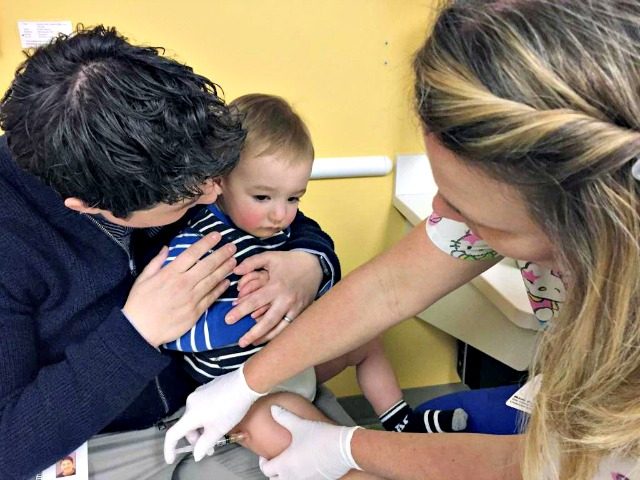The Minnesota Department of Health (MDH) reported on Monday that the number of confirmed measles cases in the outbreak that began in April has increased to 69.
For the first time, MDH is confirming that the outbreak has spread beyond the Somali community in Minnesota to white and Hispanic residents of the state. Fifty-nine of the 69 cases of measles are in Somali Minnesotans, seven are white/Non-Hispanic, and three are white/Hispanic, MDH reported.
Though the number of cases continues to grow, the cases have not spread beyond four counties:
- 59 in Hennepin County
- 4 in Ramsey County
- 4 in Crow Wing County
- 2 in Le Sueur County
Three cases are in adults, 66 are in children (ages 0-17 years).
Sixty-five of the 69 cases have been “confirmed to be unvaccinated.” Of the remaining four cases, “1 had 1 dose of MMR [and] 3 had 2 doses of MMR.”
Since 1997, the number of measles cases diagnosed in Minnesota has exceeded double digits only once, in 2011, when 26 cases were diagnosed.
The current measles outbreak is the largest in the state since 1990, when a total of 460 cases of measles were confirmed.
Experts say the outbreak is likely to continue to spread.
MDH officials have said the initial infection that sparked the current measles outbreak was due to a foreign traveler.
“Measles is a rare disease in Minnesota and in the U.S.; however, measles is still common in other parts of the world. Most measles cases occurring in Minnesota result from someone traveling to or from countries where measles is common, and who are infectious with measles after arriving in Minnesota,” the MDH website states.
As part of its public information program to promote vaccinations, MDH offers a Think Measles “[l]etter size poster with a reminder to get vaccinated for measles before international travel,” that is available in nine languages, including English, Amharic, Hmong, Khmer, Oromo, Somali, Spanish, Tagalog, and Vietnamese.
The outbreak began in the Somali community, which has seen vaccination rates plummet over the past decade. MDH officials blame that drop in vaccination rates on anti-vaxxers who have spread the medically discredited claim that vaccinations are tied to autism to the Somali community in Minnesota.
Minneapolis-St. Paul is home to the largest Somali community in the United States, estimated to be about 70,000 in total.
“Since FY 2002, 100,246 Somali refugees have resettled in the United States, according to the State Department’s interactive website,” Breitbart News reported in December.
In Olmsted County, which is about 70 miles southeast of Le Sueur County, “a public forum has been scheduled for Monday evening in Rochester to discuss Minnesota’s worst measles outbreak since 1990,” the Post Bulletin reported:
The Somali Health Advisory Committee has organized the forum in hopes of addressing the Somali community’s increasing resistance to the MMR vaccine because of fears of its links to autism, a claim that has been debunked repeatedly by the science community.
Abdirashid Shire, director of Rochester’s Health and Research Institute for Somali Americans, and Nasra Giama, a nursing professor at the University of Minnesota Rochester and a Mayo Clinic researcher, will lead the discussion.
Representatives from Mayo Clinic, Olmsted Medical Center, Olmsted County Public Health and Minnesota Department of Health are expected to attend and participate in the discussion.
“The primary goal is to talk about childhood health issues, specifically about trying to dispel the myth about the link between MMR and autism and the importance of vaccines,” Dawn Beck, associate director of the Olmsted County Public Health, told the Post Bulletin:
Despite ongoing efforts from MDH and other health agencies in recent years, Minnesota’s Somali community has seen its vaccination rate plunge from nearly 90 percent to the mid-40s. In Olmsted County, Somalis have an MMR vaccination rate of 75 percent, according to 2016 data.
Despite good news locally, Olmsted County’s recent Community Health Needs Assessment identified immunizations as one of its top five priorities in 2017.
Minnesota state officials now believe the current measles outbreak, combined with increased rates of tuberculosis and syphilis, has become a significant public health problem in the state.
Minnesota Health Commissioner Ed Ehlinger said earlier this month:
In recent months, state and local public health officials have had to respond to a series of infectious disease outbreaks including multi-drug resistant tuberculosis, hundreds of new cases of syphilis, and now, the largest measles outbreak the state has faced in nearly 30 years. These outbreaks come on the heels of extensive public health efforts in 2016 for the Zika virus response and in 2014-15 for Ebola preparedness.
With state and local response costs for the first half of 2017 approaching $3 million just for measles, tuberculosis and syphilis, I respectfully request that the legislature create a public health response contingency fund of $5 million to ensure sufficient resources are available for immediate, life-saving actions to protect Minnesotans from infectious disease outbreaks and other unanticipated public health threats.
“Governor Dayton has given me his support for this proposal and we will advocate for its inclusion in any final legislative budget agreement,” Ehlinger noted.

COMMENTS
Please let us know if you're having issues with commenting.